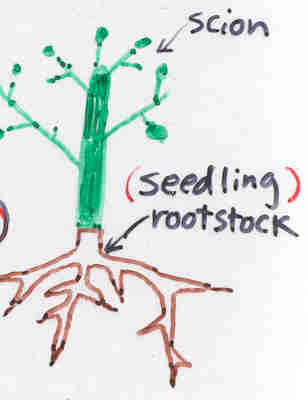PRINCIPLES AND PRACTICES OF SEED SELECTION
I. USE OF SEEDS IN PROPAGATION
A. For mass propagaiton
-Inexpensive
-Crops:
Agronomic crops (cereals, forage, oil crops, grass)
Bedding plants
Some herbaceous perennials, pot plants
Forest crops
Woody ornamentals
B. For root
stocks
-Fruit
crops
-Woody
landscape plants (maple)
-Some
vegetables (watermelon on gourd stock -in Japan due to resistance to nematode
fursarium wilt)
C. For plant breeding
II. CONTROL OF GENETIC UNIFORMITY
A. Self-pollinated
species (wheat, barley, rice) 
Inbreeding
results in homozygous genotypes
Pureline-----inbred line that does not segregate
multiline-----combined several purelines (isolines, for specific traits)
B. Cross-pollinated species (cucurbits, conifers, walnut, flowers)
1. Inbred
lines-----problem with "Inbreeding depression" -Homozygous
2. Hybrid
lines----Hybrid vigor (heterozygous, homogeneous)
3. Synthetic
cultivars--seeds from random cross pollination of selected parental plants
(i.e. Alfalfa)
III. SEED PRODUCTION IN HERBACEUS CULTIVARS
A. Control
genetic uniformity by isolation, roguing
B. Controlled
pollination ---selfing, hybridizing
C. Use of Apomixic
seeds
D. Somatic embryogenesis
- synthetic seeds (cell cultures)
E. Seed distribution
IV. SEED SOURCES FOR WOODY PLANTS
Genetic variability is extensive
most woody plants are cross-pollinated --heterozygous
A. Genetic
Variability
1) Within
seed sources -- cross pollination by adjacent trees
2) Among seed sources (seed origin)
B. Source Selection
-phenotypic
selection -- seed parents
-genotypic
selection -- study of segregating progenies
-seed
selection zone (hardiness zone)
C. Seedling
Root Stocks for Fruit, Nut Crops
-A wide
geographic location for seed collection
-used
for many crops- peach, apple, pear, cherry
D. Use of Hybrids
-controlled
pollination
E. Seed Production
-productin
areas (CA, OR, WA)
-Seed
orchards
root stocks
forest trees
V. SEED CERTIFICATION AND PATENT PROTECTION
A. Plant Variety
Protection Act (1970) revised 1994
-The breeder
applies to the USDA for a Plant Variety Protection Act
-A new
cultivar should be:
a. different from all known cultivars (morphological, physiological)
b. uniform
c. stable
d. have commercial value
-Certificate
is good for 17 years
B. Federal
Seed Act
-Only
certified seeds can be sold by cultivar name
-Stimulates
commercial development by seed companies